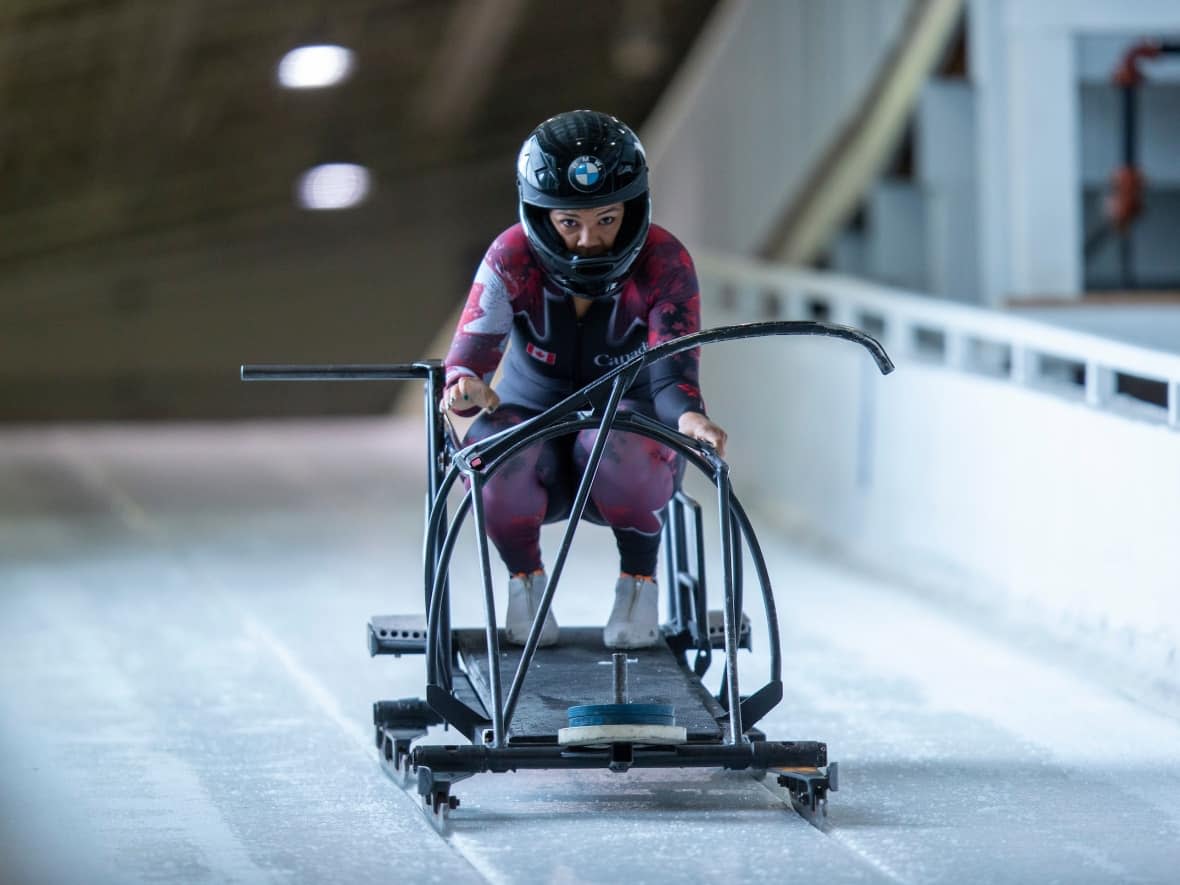Canadian Olympic talent search expands to focus on Indigenous youth

It's an opportunity Canadian bobsledder Eden Wilson would have jumped at.
RBC Training Ground announced earlier this week it would host custom testing events for North American Indigenous Games (NAIG) provincial delegations, including Alberta and Saskatchewan, in addition to its usual complement of events for young athletes to test their skills in different sports.
Wilson, who is Black and Indigenous, competed in equestrian as a show jumper, before meeting Olympian Phylicia George, who convinced her to enter the sliding world.
The RBC Training Ground ambassador said she's happy to be a role model for young Black, Indigenous and people of colour (BIPOC) athletes who may not otherwise consider bobsleigh.
"For me, it always boils down to if there's not a seat at the table for you, you never show up to the table," she said. "[It's] the idea that until you see somebody in your sport doing what you want to do, it's unlikely that you'll ever take the steps to try it."
NAIG, which has athletes competing in 16 different sports including three traditional Indigenous sports (canoe/kayak, lacrosse and archery), is set to take place over eight days in July across Kjipuktuk (Halifax), Dartmouth, and Millbrook First Nation.

In its eighth year, Training Ground is a joint project of the Canadian Olympic Committee and sponsor RBC. Athletes across Canada between the ages of 14 and 25 are put through a series of speed, power, strength and endurance tests in regional qualifiers, and advance to a final, in hopes of pairing them with an Olympic sport.
Were it not for that "right place, right time" encounter with George, Wilson may never have thought about sliding.
"It's crazy to think that I would get in a tin can and go faster than I do in my car on the highway. But for me trying something new as an adult was definitely the hardest part about it. But I fell in love with it and I fell in love with the community that's created by sport," Wilson said.
The 25-year-old athlete now has her eyes set on reaching the 2026 Olympics as a bobsleigh pilot. She grew up on her Métis grandmother's farm in Plumas, Man., where she learned how to ride horses.
She said it was "tough" being a biracial athlete in show jumping, but bobsleigh is "different."
"When people think of bobsleigh, they think of [the movie] Cool Runnings. So it seems to be a little bit more, I wouldn't say progressive in the way that it's moving along, but it is a little more acceptable to essentially like biracial or BIPOC in bobsleigh specifically," she said.
Wilson joked that if she had attended an RBC Training Ground, she'd have ended up in a summer sport "because who wants to be out in minus-30?"
But as an athlete who has competed in vastly different sports, she knows the value of testing your skills in different areas — especially for those who might not have the same access.
"For a lot of these athletes, it's going to be the first time that they are able to try the same equipment as everybody else, be at the same combine as everybody else, they're ranked against everybody else. So it's definitely going to be a great experience and a great opportunity for everybody involved."
'Nothing like that feeling'
Brigette Lacquette remembers when she was younger, sitting at her kitchen table in the remote Métis community of Mallard, Man., and setting goals for herself. Those goals included things like getting a scholarship to play hockey in the U.S., to graduate, and to play for Team Canada.
In 2018, after attending Minnesota-Duluth University, Lacquette – whose father is from the O-Chi-Chak Ko Sipi First Nation of Manitoba and whose mother is from the Cote First Nation in Saskatchewan – became the first Indigenous player to suit up for Canada's Olympic women's hockey team.
"Slowly checking those boxes off, there's nothing like that feeling," she said.
Lacquette, now 30, said that even though she's now a spokesperson for RBC Training Ground, she may have declined an opportunity as a young athlete because it "would probably be out of [her] comfort zone."
WATCH | Lacquette discusses inclusion, diversity in hockey:
But now, as a veteran hockey player who also participates in the Professional Women's Hockey Players' Association's Dream Gap Tour, she understands how much easier it would make things for athletes like her who had to drive an hour each way just to get to practice.
"Find something that you find fun, that you love to do and I guess my passion was hockey, but pick anything that interests you and the goals for yourself and do everything you can to achieve it," she said.
Lacquette said she didn't understand the importance of her position as the first Indigenous player on the Olympic team at first, but as more and more speaking engagements came about, she began to feel the impact she could make.
"I feel like sharing my story shows young Indigenous youth that they can achieve anything that they set their mind to," she said.
The goal of the RBC Training Ground expansion is to turn those dreams into reality, and create more Olympic medal hopefuls for Team Canada.
Eric Myles, chief sport officer of the Canadian Olympic Committee, called the program "a valuable incubator."
"Alongside our sport partners, we are so proud to be part of this incredible program. It's important that more athletes from Indigenous communities get the opportunity to compete on the national and international stage, and we're looking forward to watching this next generation of athletes pursue their Olympic dreams."


